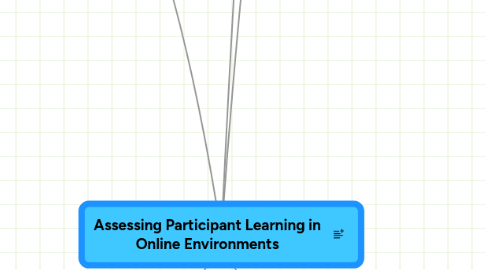
1. Confusion between Assessment & Evaluation
1.1. Because same data used to analyse learning and measure program effectiveness
1.2. Assessment is the activity of measuring student learning, and characteristics such as aptitude and motivation
1.2.1. Three key components to provide helpful guidance for learners and instructors
1.2.1.1. Measurement of learning objectives
1.2.1.2. Self-assessment for students to measure their own achievements
1.2.1.3. Interaction and feedback between and amongst instructor and students
1.2.2. Challenges
1.2.2.1. Are assessments accurate?
1.2.2.2. Are they fair to all learners?
1.2.2.3. Do they measure what they are intended to measure?
1.3. Evaluation judges effectiveness and worth of programs and products
2. Assessment Taxonomies
2.1. Assessment by purpose
2.1.1. Diagnostic assessment
2.1.1.1. Provides an indicator of learners aptitude. preparedness & ID's possible learning problems
2.1.2. Formative assessment
2.1.2.1. Provides learners with feedback on progress & informs development
2.1.2.2. Does not contribute to overall assessment
2.1.2.3. Goal is to improve teaching & learning
2.1.3. Summative assessment
2.1.3.1. Provides measure of achievement in respect to learners performance in relation to intended outcomes
2.1.3.2. Process of gathering, describing or quantifying info about learner performance
2.2. Traditional
2.2.1. Position learners as 'recipients of knowledge whose function is to absorb a body of information'
2.2.2. Measure learning at lowest level of Blooms cognitive domain: knowledge & comprehension
2.2.3. Assessment instruments
2.2.3.1. Fill-in-the-blank
2.2.3.2. True/False
2.2.3.3. Matching
2.2.3.4. Multi-Choice
2.3. Alternative
2.3.1. Position learners as 'extremely active in the process of learning'
2.3.1.1. encourage and enabled to go beyond surface answers using higher-level thinking skills
2.3.1.1.1. Synthesis
2.3.1.1.2. Analysis
2.3.1.1.3. Evaluation
2.3.1.2. Learning that falls into affective domain
2.3.1.2.1. Feelings
2.3.1.2.2. Values
2.3.1.2.3. Appreciation
2.3.1.2.4. Enthusiasm
2.3.1.2.5. Motivations
2.3.1.2.6. Attitudes
2.3.2. Assessment instruments
2.3.2.1. Social learning
2.3.2.2. Collaboration
2.3.2.3. Team activities
2.3.2.4. Peer evaluations
2.3.2.5. Self-evaluations
2.3.2.6. Portfolios
2.4. Performance Assessment
2.4.1. Measure psychomotor domain
2.4.1.1. Demonstrations of competence in skill or task
2.4.1.2. focused on learners ability to apply knowledge, skills and judgement in ill-defined realistic contexts
2.4.2. Key attributes
2.4.2.1. Focus on complex learning
2.4.2.2. Involves higher-order cognitive skills
2.4.2.3. Stimulates a wide range of active responses
2.4.2.4. Involves challenging tasks that require multiple steps
2.4.2.5. Requires significant time and effort
3. Assessment is key component of any Teaching and Learning System
3.1. Needs to be ongoing process, integrated throughout course
3.2. Should consist of multiple measures
4. Assessing in Online environments
4.1. Challenges
4.1.1. Critical because of lack of f2f direct observation
4.1.2. Academic dishonesty
4.1.2.1. Learner ID
4.1.2.2. Work ownership/Plagarism
4.2. Benefits
4.2.1. Technologies that provide extra capabilities beyond traditional classrooms
4.2.1.1. Allows every student to respond to every question instructors ask
4.2.1.1.1. email provides ability to provide fresh responses, free from peer influence
4.2.1.1.2. Discussion threads enable them to build on others thoughts
4.2.1.2. Instructor can provide immediate feedback to each learner
5. Online Assessment Strategies & Techniques
5.1. 3 Questions to answer when developing
5.1.1. What is being assessed?
5.1.2. What is the purpose?
5.1.3. What is the scope?
5.2. Successful strategies answer the 3 questions and combine (depending on domain of outcome)
5.2.1. Diagnostic
5.2.2. Formative
5.2.3. Summative
5.2.4. Traditional
5.2.5. Alternative
5.3. Techniques
5.3.1. Selected response
5.3.1.1. Multi-Choice
5.3.1.2. True/False
5.3.1.3. Matching
5.3.2. Constructed response
5.3.2.1. Fill in the blanks
5.3.2.2. Short answer
5.3.2.3. Show your work
5.3.2.4. Visual depiction
5.3.3. Virtual Discussions
5.3.3.1. Synchronous
5.3.3.1.1. Expected time of arrival
5.3.3.1.2. Responds voluntarily
5.3.3.1.3. Responds when prompted
5.3.3.1.4. Generates new ideas
5.3.3.2. Asynchronous
5.3.3.2.1. Allows users to construct and craft answers through thoughtful reflection
5.3.3.3. Rubrics
5.3.3.3.1. direct students towards effective discussions
5.3.3.3.2. Make assessing easier
5.3.3.3.3. Should include:
5.3.4. Concept mapping
5.3.4.1. Show journey over time
5.3.4.2. Provides instructor with feedback on learner understanding
5.3.4.3. Identifies where instructional emphasis is needed
5.3.5. Portfolio
5.3.5.1. Shows solution and process of journey
5.3.5.1.1. Evidence of complex cognitive process to construct valid solution
5.3.5.2. Rubrics
5.3.5.2.1. Content
5.3.5.2.2. Clarity
5.3.5.2.3. Style
5.3.6. Writing
5.3.6.1. Feedback can be provided via track changes - Insert comment
5.3.7. Field Experiences
5.3.7.1. formats
5.3.7.1.1. Internships
5.3.7.1.2. Clinical assignments
5.3.7.1.3. Apprenticeships
5.3.7.1.4. Laboratory assignments
5.3.7.2. Assessing
5.3.7.2.1. Performance reports
5.3.7.2.2. Portfolios
5.3.7.2.3. Journals
5.3.7.2.4. Video
5.3.7.3. Rubrics
5.3.7.3.1. Detailed project descriptions
5.3.7.3.2. Dates and times
5.3.7.3.3. Learning expectations
5.3.8. Problem-Solving simulations
5.3.9. Individual and Group projects
5.3.10. Informal student feedback
5.3.11. Peer feedback
5.3.12. Self-Assessment
